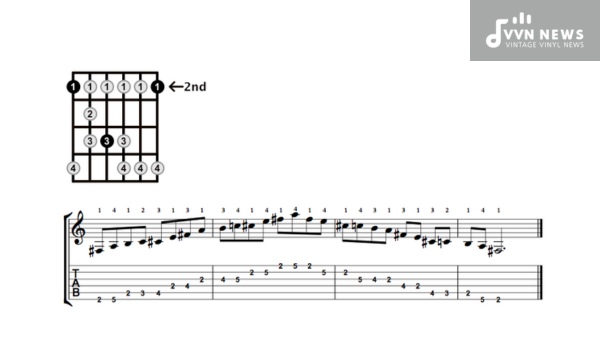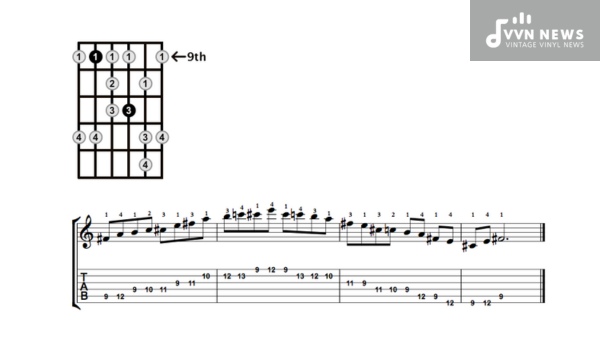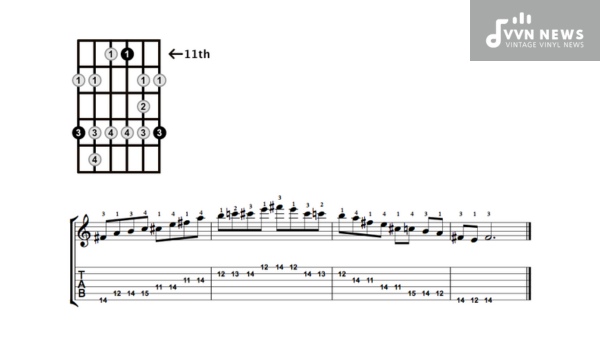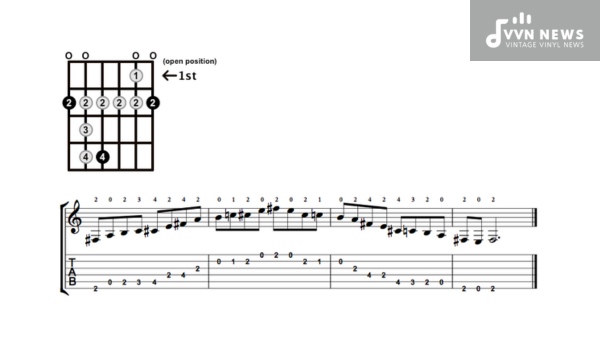If you’ve ever been captivated by the soulful sounds of blues music, then the F sharp minor blues scale holds the keys to that emotive depth.
This particular scale, with its distinct melodic qualities, serves as a foundation for countless classic riffs and solos that have stood the test of time.
As a building block in both blues and rock genres, mastering the F sharp minor blues is an essential step for any aspiring guitarist looking to infuse their playing with that mournful yet spirited essence so characteristic of blues music.
Navigating through this scale might seem daunting at first, but I assure you it’s worth every minute spent refining your technique.
Understanding how the F sharp minor blues scale is constructed and where each note fits in the grand tapestry of music enhances your improvisational skills and musical expression.
As we take a closer look at this dynamic scale, you’ll discover just how versatile and expressive your guitar playing can become by incorporating these rich, bluesy tones into your repertoire.
The Composition of the F Sharp Minor Blues Scale
The F sharp minor blues scale is formulated with a specific set of notes: F#, A, B, C, C#, and E.
These six pitches blend to create a hauntingly melodic tone, one often associated with emotive guitar licks.
The inclusion of the blues note, C in this case, adds a layer of complexity and depth.
This note is a diminished fifth, positioned between the fourth (B) and the fifth (C#) degrees of the scale.
Its presence contributes to that quintessential bluesy sound—that raw emotional power that can bring a piece to life for listeners.
Steps to Construct the F Sharp Minor Blues Scale

To construct the F sharp minor blues scale, begin with its relative major key, A Major. The minor blues scale traditionally follows a pentatonic structure with an added chromatic “blue” note to instill that signature bluesy tension.
Here are the steps:
- Start with the F# minor pentatonic scale: F#, A, B, C#, and E.
- Add the “blue note,” which is a diminished fifth (or augmented fourth) from your root note. In this case, it’s C natural.
- The complete scale now reads as: F#, A, B, C, C#, and E.
By using this formula, you’ve now unlocked the moody allure of the F sharp minor blues scale. Practice it in various positions across your fretboard to truly capture its expressive potential within your solos and improvisations.
Exploring the Shapes of the F Sharp Minor Blues Scale
The F sharp minor blues scale is a versatile and rich palette for guitarists. It comprises frequent use of bends, slides, and vibrato, lending expressive nuance to your playing. By learning its various shapes across the fretboard, you unlock new creative possibilities. Let’s delve into five key shapes that can transform your musical expression.
Also Read: C Sharp Major Pentatonic Scale [Crisp & Clear Tones For Your Music]
Shape 1: The Open Position
Begin with the open position which extends from the nut to the fourth fret. Frets to focus on are:
- 2nd and 4th (low E string)
- 2nd and 4th (A string)
- 1st, 2nd, and 4th (D string)
This position offers an accessible entry point with its convenient placement.
Shape 2: The Box Pattern
The “box pattern” is anchored between the fourth and seventh frets. Notably:
- Emphasize frets 4 and 7 (low E string)
- Fret those same positions on the A string
- Hit frets 4, 5, and 7 on the D string
Navigate through this shape; it’s a staple for soloing.
Shape 3: Extension Up the Neck
From frets seven to ten:
- Cover frets 7 and 9 (low E & A strings)
- Include frets 7,9,10 (D & G strings)
This shape leads seamlessly into higher registers.
Shape 4: Two-Octave Stretch
Reaching across frets nine to twelve allows players to span two octaves of the scale. Primarily:
- Utilize frets 9 and 12
- Incorporate A-string counterparts
- Extend to include D at frets nine through eleven
Master this region for expansive melodic journeys.
Shape Five: The Upper Stratification
Finally, beyond the twelfth fret—the epitome of fluidity in blues soloing:
- Target notes at positions twelve and fourteen
- Ensure equal attention to corresponding A strings
- Ascend into high-flying melody lines with assuredness
By integrating these five shapes of the F sharp minor blues scale, your solos will not only gain sophistication but also authenticity that resonates with any audience.
Each shape offers its own flavor; mastery allows them to interweave dramatically within a musical pieces.
Also Read: A Sharp Minor Pentatonic Scale [Unique Harmonic Possibilities]
Contrast Between F Sharp Major and Minor Blues Scales

F Sharp Major and Minor Blues scales are two distinct entities that provide diverse palettes for musicians to paint their musical landscapes.
The F Sharp Minor Blues scale is characterized by its darker, more somber tones.
It is built upon the natural minor scale with an added flat fifth – often referred to as the “blue note” – which injects a dose of soul and expressiveness into the scale.
This scale consists of the following notes: F#, A, B, C, C#, E. The “blue note,” C in this case, adds an extra layer of complexity and a gritty flavor that’s synonymous with the blues genre.
On the flip side, the F Sharp Major Blues Scale emanates brighter, more upbeat vibes.
It originates from the major pentatonic scale with a similarly added blue note that gives it a bluesy twist without losing its major tonality.
Here are the notes for the F Sharp Major Blues Scale: F#, G#, A#, B, C, C#.
Fusing the b3 (A#) into this series of pitches creates a jubilant shuffle that’s perfect for brighter blues or even country music.
In essence:
- Minor Blues: Deeper and more poignant
- Major Blues: Lighter and cheerier
By alternating between these scales over different chords and progressions, you can weave an intricate audio tapestry that captures every shade of human emotion.
Whether your fingers dance on frets or keys, these scales are essential for crafting compelling blues narratives.
Recommended Practice Tracks for the F Sharp Minor Blues Scale
When it comes to honing your skills with the F Sharp Minor Blues Scale, immersing yourself in the right practice tracks can elevate your proficiency remarkably.
I’ve compiled a list of tracks that will not just serve as a solid foundation but also inspire creativity as you navigate this soulful scale:
- “The Thrill Is Gone” by B.B. King – A quintessential blues number that features captivating guitar work ideal for practicing your phrasing over minor blues scales.
- “Since I’ve Been Loving You” by Led Zeppelin – Jimmy Page offers a masterclass in emotion-filled bends and extended solos fitting perfectly within the F# minor blues framework.
- “Black Magic Woman” by Santana – Carlos Santana’s smooth yet intricate playing is perfect for exploring the nuances within the scale’s territory.
In each of these songs, the lead guitar work rests heavily on minor blues tonalities and they provide various tempos and rhythmic feels to experiment with.
Practicing along to B.B. King’s track allows you to delve into slower, more expressive playing, giving each note room to breathe.
Since I’ve Been Loving You offers a grittier texture, which can test your ability to build tension and release while bending and sustaining notes within the scale.
Meanwhile, Black Magic Woman pushes you into a zone of Latin-infused blues, adding rhythmic complexity and novel sonic dimensions where syncopated patterns reign supreme.
These selections vary in mood and tempo, challenging both novices and seasoned players alike.
Also Read: D Sharp Minor Pentatonic Scale [Inject Drama Into Your Melodies]
Importance of Ear Training in Learning F Sharp Minor Blues Scales

As a musician, cultivating a sharp ear is as vital as mastering your instrument.
With ear training, you fortify your musical foundation, and nowhere is this truer than in learning the F sharp minor blues scale.
The nuances in blues music—a genre that relies heavily on emotion and feel—demand keen auditory skills to capture the essence of what makes it so resonant.
- Enhances Recognition: Ear training allows you to distinguish individual notes and nuances within the scale, aiding in more accurate pitch reproduction on your instrument.
- Improves Improvisation: When your ear is tuned to the distinctive sounds of the F sharp minor blues scale, it’s easier to improvise and create emotive solos that resonate with listeners.
- Facilitates Transcription: With a well-trained ear, transcribing songs and identifying the use of the F sharp minor blues scale in various tracks becomes a simpler task.
- Memorization Aid: By consistently listening and playing along, musicians find that scales and patterns become ingrained, reducing reliance on visual cues such as fretboard markers or sheet music. Benefits for Musicians:
- Better Timing: Learning by listening helps develop a natural sense of timing and rhythm that is crucial for blues performance.
- Creative Expression: The ability to recognize scale degrees by ear opens up a broader palette for artistic expression.
- Adaptability: Being proficient in ear training enables musicians to quickly adapt to different musical settings where the F sharp minor blues scale might be applied.
Ear training is not merely an exercise but an essential tool for any musician delving into the expressive world of blues scales.
Also Read: F Sharp Major Chords [Boost Your Guitar Skills Today]
FAQs on the F Sharp Minor Blues Scale
What is unique about the F Sharp Minor Blues Scale?
The F Sharp Minor Blues Scale adds a bluesy touch with its flat fifth (also known as the blue note), distinguishing it from the standard minor pentatonic scale.
Can I use the F Sharp Minor Blues Scale over major chords?
Yes, you can use it over major chords, especially dominant 7th chords, to create a tension and release effect that is typical in blues music.
How often should I practice this scale to see improvement in my playing?
Consistent daily practice, even for just 15-20 minutes, can lead to noticeable improvements in your familiarity and fluidity with the scale.
Are there any well-known songs that employ the F Sharp Minor Blues Scale?
Many blues and rock songs utilize this scale. Notable examples include tracks by B.B. King and Eric Clapton—artists renowned for their blues guitar work.
Is there an easy way to start improvising with this scale?
Begin by learning one octave of the scale and experiment with these notes over a simple backing track to get comfortable before expanding your range.
Conclusion
In wrapping up, the F sharp minor blues scale is not only a tool for enhancing your musicality but acts as a gateway to a more profound emotional expression.
Incorporate practice, familiarize yourself with different scale shapes, and engage in ear training to unlock its full potential.
Embrace this scale’s versatility and watch as it transforms your playing, inviting you to join the ranks of legendary musicians who’ve all leaned on these poignant notes to tell their own unique stories.








